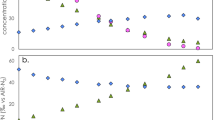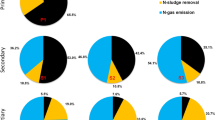Abstract
Denitrification has been measured during the last few years using two different methods in particular: isotope pairing measured on a triple-collector isotopic ratio mass spectrometer and N2:Ar ratios measured on a membrane inlet mass spectrometer (MIMS). This study compares these two techniques in short-term batch experiments. Rates obtained using the original N2∶Ar method were up to 3 to 4 times higher than rates obtained using the isotope pairing technique due to O2 reacting with the N2 during MIMS analysis. Oxygen combines with N2 within the mass spectrometer ion source forming NO+ which reduces the N2 concentration. The decrease in N2 is least at lower O2 concentrations and since oxygen is typically consumed during incubations of sediment cores, the result is often a pseudo-increase in N2 concentration being interpreted as denitrification activity. The magnitude of this ocygen effect may be instrument specific. The reaction of O2 with N2 and the subsequent decrease in N2 was only partly correctly using an O2 correction curve for the relationship between N2 and O2 concentrations. The O2 corrected N2∶Ar denitrification rates were lower, but still did not match the isotope pairing rates and the variability between replicates was much higher. Using a copper reduction column heated to 600°C to remove all of the O2 from the sample before MIMS analysis resulted in comparable rates (slightly lower), and comparable variability between replicates, to the isotope pairing technique. The N2:Ar technique determines the net N2 production as the difference between N2 production by denitrification and N2 consumption by N-fixation, while N-fixation has little effect on the isotope pairing technique which determines a rate very close to the gross N2 production. When the two different techniques were applied on the same sediment, the small difference in rates obtained by the two methods seemed to reflect N-fixation as also supported from measurements of ethylene production in acetylene enriched sediment cores. The N2:Ar and isotope pairing techniques may be combined to provide simultaneous measurements of denitrification and N-fixation. Both techniques have several assumptions that must be met to achieve accurate rates; a number of tests are outlined that can be applied to demonstrate that these assumptions are being meet.
Similar content being viewed by others
Literature Cited
An, S., W. Gardner, andT. Kana. 2001. Simultaneous measurement of denitrification and nitrogen fixation using isotope pairing with membrane inlet mass spectrometry analysis.Applied and Environmental Microbiology 67:1171–1178.
An, S. andS. B. Joye. 1997. An improved gas chromatographic method for measuring nitrogen, oxygen, argon and methane in gas or liquid samples.Marine Chemistry 59:63–70.
Berelson, W. M., D. Heggie, A. Longmore, T. Kilgore, G. Nickolson, andG. Skyring. 1998. Benthic nutrient recycling in Port Phillip Bay, Australia.Estuarine, Coastal and Self Science 46:917–934.
Braman, R. S., andS. A. Hendrix. 1989. Nanogram nitrite and nitrate determination in environmental and biological materials by vanadium (III) reduction with chemiluminescence detection.Analytical Chemistry 61:2715–2718.
Broast, C. W., R. L. Mulvaney, andP. Baveye. 1988. Evaluation of the nitrogen-15 tracer techniques for direct measurements of denitrification in soil: 1 Theory.Soil Science Society of America Journal 52:1317–1322.
Capone, D. G. 1993. Determination of nitrogenase activity in aquatic samples using the acetylene reduction procedure, p. 621–631.In P. F. Kemp, B. F. Sherr, E. B. Sherr, and J. J. Cole (eds.), Handbook of Methods in Aquatic Microbial Ecology. Lewis Publishers, Boca Raton, Florida.
Cornwell, J. C., W. M. Kemp, andT. M. Kana. 1999. Denitrification in coastal ecosystems: Methods, environmental controls and ecosystem level controls, a review.Aquatic Ecology 33:41–54.
Devol, A. H. 1991. Direct measurement of nitrogen gas fluxes from continental shelf sediments.Nature 349:319–321.
Dong, L. F., D. C. O. Thornton, D. B. Nedwell, andG. J. C. Underwood. 2000. Denitrification in sediments of the river Colne estuary, England.Marine Ecology Progress Series 203:109–122.
Eye, R. D. andA. J. P. Ferguson. 2002. Comparison of carbon production and decomposition, benthic nutrient fluxes and denitrification in seagrass, phytoplankton, benthic microalgal and macroalgal dominated warm temperate Australian lagoons.Marine Ecology Progress Series 229:43–59.
Heggie, D. T., G. W. Skyring, J. Orchardo, A. R. Longmore, G. J. Nicholson, andW. M. Berelson. 1999. Denitrification and denitrifying efficiencies in sediments of Port Phillip Bay: Direct determinations of biogenic N2 and N-metabolites fluxes with implications for water quality.Marine and Freshwater Research 50:589–596.
Jensen, K. M., M. H. Jensen, andR. P. Cox. 1996. Membrane inlet mass spectrometric analysis of N-isotope labelling for aquatic denitrification studies.FEMS Microbiology and Ecology 20:101–109.
Jørgensen, B. B. 1996. Case study—Aarhus Bay, p. 137–154.In B. B. Jørgensen and K. Richardson (eds.). Coastal and Estuarine Studies. American Geophysical Union. Washington, D.C.
Kana, T. M., C. Darkangelo, M. D. Hunt, J. B. Oldam, G. E. Bennett, andJ. C. Cornwell. 1994. Membrane inlet mass O2 and Ar in environmental samples.Analytical Chemistry 66: 4166–4170.
Kana, T. M., M. B. Sullivan, J. C. Cornwell, andK. Groszkowski. 1998. Denitrification in estuarine sediments determined by membrane inlet mass spectrometry.Limnology and Oceanography 43:334–339.
LaMontagne, M. G. andI. Valiela. 1995. Denitrification measured by a direct N2 flux method in sediments of Waquoit Bay, Massachusetts.Biogeochemistry 31:63–83.
Larsen, L. H., N. P. Revsbech, andS. J. Binnerup. 1996. A microsensor for nitrate based on immobilised denitrifying bacteria.Applied and Environmental Microbiology 62:1248–1251.
Laursen, A. E. andS. P. Seitzinger. 2002. The role of denitrification in nitrogen removal and carbon mineralisation in Mid-Atlantic Bight sediments.Continental Shelf Sediments 22: 1397–1416.
Nedwell, D. B. andM. Trimmer. 1996. Nitrogen fluxes through the upper estuary of the great Ouse, England: The role of the bottom sediments.Marine Ecology Progress Series 142:273–286.
Nielsen, L. P. 1992. Denitrification in sediment determined from nitrogen isotope pairing.FEMS Microbiology and Ecology 86:357–362.
Nielsen, K., L. P. Nielsen, andP. Rasmussen. 1995. Estuarine nitrogen retention independently estimated by the denitrification rate and mass balance methods: A study of Nordsminde Fjord, Denmark.Marine Ecology Progress Series 119:275–283.
Nixon, S.W. 1981. Remineralization and nutrient cycling in coastal marine ecosystems, p. 111–113.In B. J. Nielson and L. E. J. Cronin (eds.). Estuaries and Nutrients. Humana, Clifton, New Jersey.
Nowicki, B. L. 1994. The effect of temperature, oxygen, salinity and nutrient enrichment on estuarine denitrification rates measured with a modified nitrogen gas flux technique.Estuarine, Coastal and Shelf Science 38:137–156.
Risgaard-Petersen, N., L. P. Nielsen, andT. H. Blackburn. 1998. Simultaneous measurement of benthic denitrification, with the isotope pairing technique and the N2 flux method in a continuous flow-through system.Water Research 32:3371–3377.
Risgaard-Petersen, N. andS. Rysgaard. 1995. Nitrate reduction in sediments and waterlogged soil measured by15N techniques, p. 287–310.In K. Alef and P. Nannipieri (eds.). Methods in Applied Soil Microbiology and Biochemistry. Academic Press, London, U.K.
Risgaard-Petersen, N., S. N. P. Rysgaard, andN. P. Revsbech. 1993. A sensitive assay for determination of14N/15N isotope distribution in NO3−.Journal of Microbial Methods 17:155–164.
Rysgaard, S., P. B. Christensen, andL. P. Nielsen. 1995. Seasonal variation of denitrification and nitrification in a bioturbated and microphyte inhabited estuarine sediment, Kertinge Nor (Denmark).Marine Ecology Progress Series 126:111–121.
Rysgaard, S., B. Thamdrup, N. Risgaard-Petersen, P. Berg, H. Fossing, P. B. Thamdrup, N. Risgaard-Petersen, P. Berg, H. Fossing, P. B. Christensen, andT. Dalsgaard. 1998. Seasonal carbon and nitrogen mineralization in the sediment of Young Sound, Northeast Greenland.Marine Ecology Progress Series 175: 261–276.
Seitzinger, S. P. 1987. Nitrogen biogeochemistry in an unpolluted estuary: The importance of benthic denitrification.Marine Ecology Progress Series 41:177–186.
Seitzinger, S. P. andJ. H. Garber. 1987. Nitrogen fixation and15N2 calibration of acetylene reduction assay in coastal marine sediments.Marine Ecology Progress Series 37:65–73.
Smith, L. K., J. J. Sartoris, J. S. Thullen, andD. C. Andersen. 2000. Investigation of denitrification rates in an ammonia-dominated constructed wastewater treatment wetland.Wetlands 20:684–696.
Sørensen, J. 1987. Nitrate reduction in marine sediments: Pathways and interactions with iron and sulphur cycling.Geomicrobiology Journal 5:401–421.
Sundbäck, K. andA. Miles. 2000. Balance between denitrification and microalgal incorporation of nitrogen in microtidal sediments, NE Kattegat.Aquatic Microbial Ecology 22:291–300.
Thamdrup, B. andT. Dalsgaard. 2002. Production of N2 through anaerobic ammonium oxidation coupled to nitrate reduction in marine sediments.Applied and Environmental Microbiology 68:1312–1318.
Tuominen, L., A. Heinanen, J. Kuparinen, andL. P. Nielsen. 1998. Spatial and temporal variability of denitrification in the sediments of the northern Baltic proper.Marine Ecology Progress Series 172:13–24.
Weiss, R. F. 1970. The solubility of nitrogen, oxygen and argon in water and sea water.Deep Sea Research 17:721–735.
Sources of Unpublished Materials
Christensen, P.B. Personal Communication. National Environmental Research Institute, Vejlsovej 25, 8600 Silkeborg, Denmark.
Cornwell, J. Personal Communication. University of Maryland Center for Environmental Studies, Horn Point Laboratory, P.O. Box 775, Cambridge, Maryland 21613.
Author information
Authors and Affiliations
Corresponding author
Rights and permissions
About this article
Cite this article
Eyre, B.D., Rysgaard, S., Dalsgaard, T. et al. Comparison of isotope pairing and N2:Ar methods for measuring sediment denitrification—Assumption, modifications, and implications. Estuaries 25, 1077–1087 (2002). https://doi.org/10.1007/BF02692205
Received:
Accepted:
Issue Date:
DOI: https://doi.org/10.1007/BF02692205




